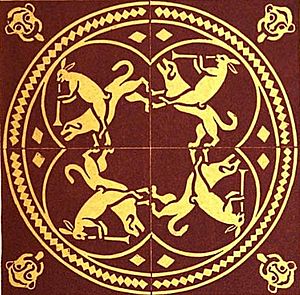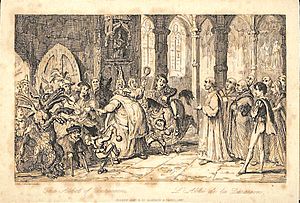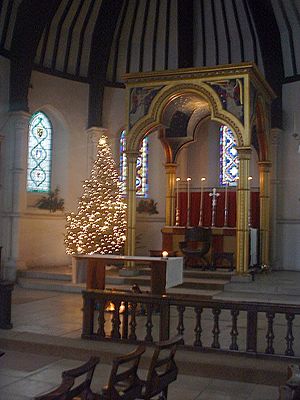Lord of Misrule facts for kids

The Lord of Misrule was a special person chosen during the Christmastide holidays in England. In Scotland, this person was called the Abbot of Unreason, and in France, the Prince des Sots. This "Lord" was usually a regular person, like a peasant or a church helper, who was put in charge of all the fun and games during Christmas celebrations.
The Church in England also had a similar tradition involving a boy bishop. This custom was stopped by King Henry VIII in 1541. It was brought back for a short time by Mary I, who was Catholic, but then stopped again by Elizabeth I, who was Protestant. Even so, it continued in some places for a while longer. In Europe, a church council tried to stop it in 1431, but it still appeared sometimes, even as late as the 1700s. During the Tudor period in England, the Lord of Misrule (sometimes called the Abbot or King of Misrule) was often mentioned in old documents. These documents talked about celebrations both at the royal court and among everyday people.
Some experts, like James Frazer and Mikhail Bakhtin, think the idea of the Lord of Misrule might come from an old Roman festival called Saturnalia. In ancient Rome, from December 17 to 23, a man was chosen to be a pretend king for the Saturnalia feast. He was like the Roman god Saturn. However, other experts believe that even though Christian traditions often borrow from older customs, the Lord of Misrule in Christian times and the Saturnalia custom might have started separately. Still, it's interesting to compare them!
Contents
History of the Lord of Misrule
Ancient Roman Customs
Around the year AD 400, a bishop named Asterius of Amasea in Turkey talked about a New Year's feast called the Feast of Calends. He described how children would visit homes, giving small gifts like fruits covered in silver. In return, they would get gifts that were worth more. This taught young minds about trading and getting rewards.
This Roman festival was very different from the Christian celebration of Christ's birth, which happened around the same time. Bishop Asterius saw the Christian feast as a move from darkness into light. The Roman festival, on the other hand, celebrated the "birth of the Unconquered Sun" during the shortest days of winter.
Even though temples were closed, the Roman festival of gift-giving continued in the city. It was a noisy and busy time, with people shouting and clapping. Beggars and performers would go from house to house, especially to the homes of important officials, until they received money. This went on late into the evening.
Some historians, like James George Frazer, have suggested a more serious side to the ancient Saturnalia festival. He mentioned that in some Roman areas, soldiers would choose a man to be a "Lord of Misrule" for thirty days. At the end of this time, he might be sacrificed. Frazer believed that the British Lord of Misrule might have similar ancient roots, where a temporary king was chosen and then put to death for the good of everyone. This idea suggests that in very old times, people might have chosen a person to act as a god for a season, and then this person would die as a sacrifice.
Tudor England's Celebrations

In the Tudor period, a writer named John Stow described the Lord of Misrule in his book Survey of London in 1603. He wrote that during Christmas, the king's house always had a Lord of Misrule, or "Master of merry disports." Important noblemen, whether church leaders or not, also had their own Lords of Misrule.
Even the Mayor of London and the sheriffs had their own Lords of Misrule. They would all try to create the most amazing entertainment for people to enjoy, without any arguments. These Lords of Misrule would start their rule on Halloween and continue until the day after Candlemas Day (February 2). During this time, there were fancy costumes, masks, and plays. People would also play card games for fun, not just for money.
Why the Custom Faded in Britain

In the 1600s, a group called the Puritans became very powerful in the Anglican Church. They thought the custom of the Lord of Misrule was too wild and "disruptive," so they outlawed it. Even after the king was restored to power, the custom stayed banned and was eventually forgotten.
However, in the early 1800s, a movement called the Oxford Movement in the Anglican Church helped bring back a more religious and symbolic way of celebrating Christmas. They built new churches and made Christmas a more central Christian festival. They also started special charities for the poor and held special church services and music events. Writers like Charles Dickens also helped to change how people thought about Christmas. They focused on family, religion, giving gifts, and bringing people together, instead of just the wild parties that used to happen in some places.
See also

